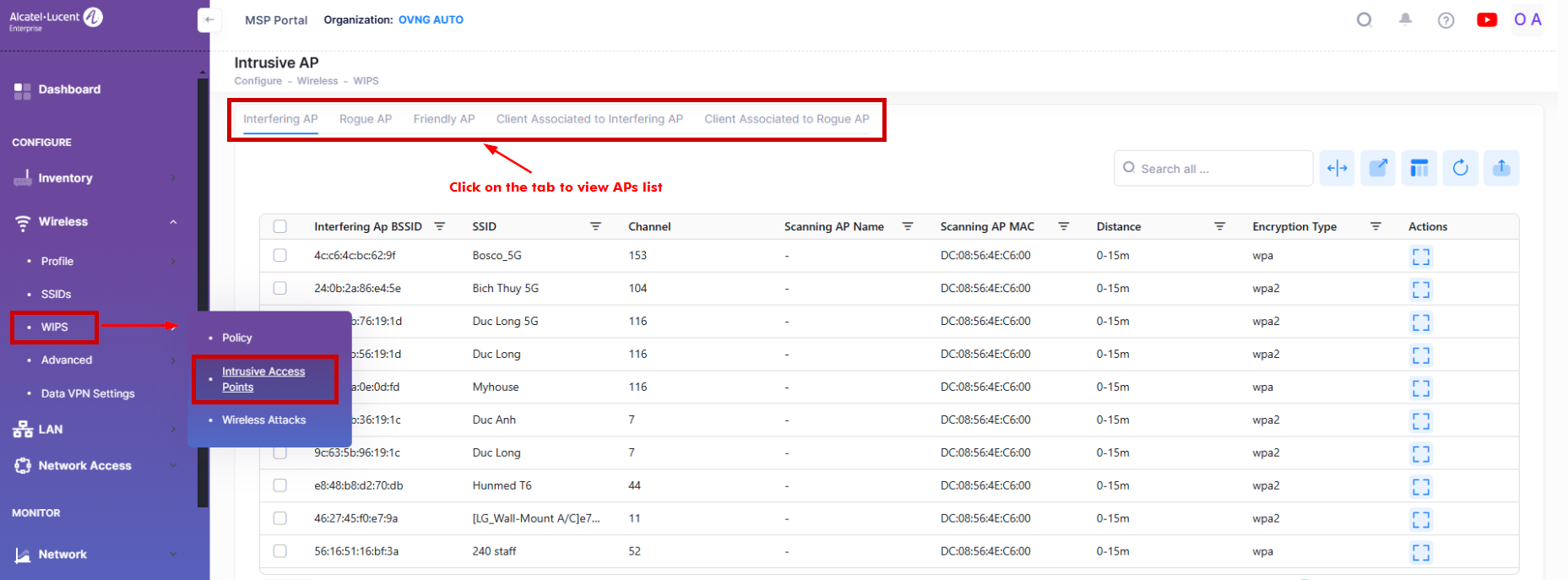Intrusive Access Points
The WIPS Intrusive Access Points screen displays information about Intrusive APs on the network including Interfering APs, Rogue APs, Friendly APs, Clients Associated to an Interfering AP, and Clients Associated to a Rogue AP. To access the WIPS Intrusive Access Points screen, click on Wireless > WIPS > Intrusive Access Points under the “Configure” section of the OmniVista Cirrus Menu.

By default, the “Interfering AP” list is displayed. Click on one of the other list names to display the contents of other lists. For example, click on the “Friendly AP” tab to display the list of APs declared as “friendly”.
A device on the "Interfering AP" list and “Rogue AP” can be added to the “Friendly AP” list by selecting the device(s) in the list, then selecting Add to Friendly from the “Actions” drop-down menu.
Clients on the "Client Associated to an Interfering AP" list and the "Client Associated to a Rouge AP" list can be added to the Client Blocklist by selecting the Client(s) in the list, then selecting Add To Client Blocklist from the “Actions” drop-down menu.
The devices are not moved from one list to the other, but added to the other list, so that the WIPS application can maintain a history of device states.
Interfering APs
Interfering AP BSSID - BSSID of the interfering AP.
SSID - ESSID broadcast by the interfering AP.
Channel - Working channel of radio frequency on the interfering AP.
Scanning AP Name - Name of the valid AP that detected the interfering AP.
Scanning AP MAC - MAC address of the valid AP that detected the interfering AP.
Distance - Estimated distance between the interfering AP and the valid detecting AP.
Encryption Type - Encryption method of ESSID broadcast by the interfering AP.
Attached Clients - Clients associated to the interfering AP.
Signal Strength - RSSI of the interfering AP.
Last Detected Time - The latest time that the interfering AP was seen by the valid AP.
Rogue APs
Rogue AP BSSID - BSSID of the rogue AP.
SSID - ESSID broadcast by the rogue AP.
Channel - Working channel of the radio frequency on the rogue AP.
Scanning AP Name - Name of the valid AP that detected the rogue AP.
Scanning AP MAC - MAC address of the valid AP that detected the rogue AP.
Distance - Estimated distance between the rogue AP and the valid detecting AP.
Encryption Type - Encryption method of ESSID broadcast by the rogue AP.
Attached Clients - Clients associated to the rogue AP.
Signal Strength - RSSI of the rogue AP.
Last Detected Time - The latest time that the rogue AP was seen by the detecting AP.
Rogue Reason - Indicates the reason for classifying the foreign AP as a rogue AP:
Signal Strength is Too Strong, Reducing Network Performance
Channel is Switching Too Often
Broadcasting Conflicted SSID, Misleading User Connection
Matching the Keyword of Suspected SSID
Matching the Suspected MAC OUI
Friendly APs
Friendly AP BSSID - BSSID of the friendly AP.
SSID - ESSID broadcasting by the friendly AP.
Channel - Working channel of the radio frequency on the friendly AP.
Scanning AP Name - Name of the valid AP that detected the friendly AP.
Scanning AP MAC - MAC address of the valid AP that detected the friendly AP.
Distance - Estimated distance between the friendly AP and the valid detecting AP.
Encryption Type - Encryption method of ESSID broadcast by the friendly AP.
Attached Clients - Clients associated to the friendly AP.
Signal Strength - RSSI of the friendly AP.
Last Detected Time - The latest time that the friendly AP was seen by the detecting AP.
Clients Associated to an Interfering AP
Interfering Client MAC - MAC address of the interfering client.
In Blocklist - Indicates whether the client was added into the Blocklist automatically and banned from accessing the network.
SSID - ESSID to which the interfering client is associated.
Channel - Working channel of the interfering client.
Interfering AP BSSID - BSSID of the interfering AP to which the client is associated.
Distance - Distance between the interfering client and the detecting AP.
Encryption Type - Encryption method of the SSID to which the interfering client is associated.
Signal Strength - RSSI of the interfering client.
Last Detected Time - The latest time that the interfering client was seen by the detecting AP.
Clients Associated to a Rogue AP
Rogue Client MAC - MAC address of the rogue client.
In Blocklist - Indicates whether the client was added into the Blocklist automatically and banned from accessing the network.
SSID - ESSID to which the rogue associated.
Channel - Working channel of the rogue client.
Rogue AP BSSID - BSSID of the rogue AP to which the client is associated.
Distance - Distance between the rogue client and the detecting AP.
Encryption Type - Encryption method of the SSID to which the rogue client is associated.
Signal Strength - RSSI of the rogue client.
Last Detected Time - The latest time that the rogue client was seen by the detecting AP.
